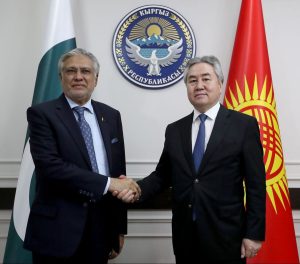On the night of May 17-18, in Bishkek, the capital of Kyrgyzstan, there were extensive attacks on dormitories housing foreign nationals. As a result, over 40 people, primarily citizens of Pakistan, India, Bangladesh, and Egypt, sustained injuries.
The Pakistani government pledged to arrange more than a dozen charter flights to repatriate affected citizens between May 19-21. In the initial days of evacuation, 3,100 students out of the 11,000 Pakistani citizens in Kyrgyzstan, predominantly enrolled in medical universities across the country, departed the country.
Currently, there are 42,620 individuals in Kyrgyzstan classified as foreign students.
Pakistani Interior Minister Mohsin Naqvi personally greeted the first batch of repatriated students from Bishkek at Lahore airport. Subsequently, Pakistani Foreign Minister Ishaq Dar highlighted Kyrgyzstan’s status as a friendly nation and stated that the incident would be addressed at a previously scheduled Shanghai Cooperation Organization (SCO) meeting in Astana on May 21. On May 22 Dar arrived in Bishkek en route back to Pakistan, where he visited victims and met with government officials. Deputy Prime Minister of Kyrgyzstan Edil Baisalov visited the affected community and offered apologies to the victims. Dar said 4,000 Pakistani students are expected to return home.
The brunt of the attacks targeted legally residing students, while the primary grievances of the spontaneous rally, which rapidly amassed approximately 1,000 young participants on the city streets from two to six in the morning, revolved around issues of illegal migration. The rally attendees asserted that illegal migration diminishes employment prospects for local youth in the labor market and propagated ethno-nationalist slogans. Notably, there was a glaring absence of dialogue between the authorities and the youth; the demonstrators demanded government representatives address their concerns directly.
The conflict has laid bare acute challenges in Kyrgyzstan’s migration policy, exposing neglected aspects of the evolving migration landscape. Traditionally regarded as a labor migrant-sending nation, Kyrgyzstan has seen a notable transformation in the last decade, transitioning into a migrant-receiving and transit country. Following the reopening of borders with Uzbekistan in 2016, Kyrgyzstan witnessed a resurgence in circular migration of construction workers from neighboring countries. Moreover, in 2022, amid the conflict in Ukraine, Central Asian countries actively began accepting migrants from Russia. The events of May 18-19 have underscored numerous governmental deficiencies and laid bare the unpreparedness of key institutions to address the array of challenges stemming from these shifting dynamics.
Historically, the focal points of the country’s migration policy have centered on diversifying labor markets for Kyrgyzstani migrants and attracting capital from migrants and the diaspora to Kyrgyzstan. However, scant attention has been directed toward understanding how migration dynamics impact the domestic labor market and rural economy, and the emerging security challenges posed by the rapid transformation of the country’s migration profile.
In political discourse, outward labor migration has conventionally been framed as a poverty alleviation mechanism, with potential for broader economic development. Nevertheless, the ramifications of labor migration on various sectors of the local economy remain ambiguous. Studies indicate that labor migration from rural areas of Kyrgyzstan abroad has resulted in a significant exodus of labor from the country’s unproductive agricultural sector, transforming Kyrgyzstan from a net food exporter into a country heavily reliant on imports.
Domestic labor shortages are also evident in numerous sewing workshops, another vital economic sector. Due to wage disparities, many workers in light industries, having gained experience in Kyrgyzstan, migrate onward to Russia where hourly wages are higher. Consequently, labor migration from Kyrgyzstan to more lucrative labor markets has led to the displacement of remaining local workers by migrants from nearby and even distant regions.
Since 2020, the government has consistently increased the quota for foreign labor migrants; in 2024, the quota reached 25,000, up from 16,610 the previous year. Foreign labor is predominantly sourced from Bangladesh, Pakistan, and China. Industrial, construction, and transport sectors received 63 percent of the quota, while 13 percent went to the mining industry, and 14 percent to the service and trade sectors.
The preference for foreign labor is partly attributed to alleged deficiencies in the work ethic of local workers, as articulated by President Sadyr Japarov. Reflecting on the engagement of foreign labor for the construction of a new government complex in 2023, Japarov cited instances of local workers’ purported laziness, justifying the decision to recruit 800 workers from Bangladesh.
During the rally on May 18, several key demands were voiced, including the expulsion of illegal foreign workers who create competition in the labor market and depress wages for locals, and urging authorities to engage in dialogue with the demonstrators.
Official figures from the Ministry of Internal Affairs suggest a low incidence of illegal migration; for instance, in the first quarter of 2024, approximately 60 individuals were identified, with 264 criminal cases initiated at the start of the year. However, the second demand from the rally participants appears to be a response to the president’s assessment of local prospects in the labor market for young Kyrgyz man made a year prior.
Japarov and the head of the State Committee for National Security, Kamchybek Tashiev, issued statements regarding the recent events. The president suggested that prompt action by law enforcement agencies and transparent communication with the public could have averted the violence. Meanwhile, Tashiev acknowledged the validity of some demands made by the protesters and affirmed the government’s commitment to intensifying efforts to identify illegal immigrants.
Japarov attributed the events to an alleged attempt to foment unrest by opponents of the government, indicating a readiness to employ force to quell future such rallies. This narrative of conspiracy detracts from addressing the genuine challenges within the labor market and the significant shifts in the country’s migration landscape.

































